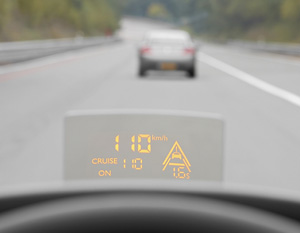
Johnson Controls Inc. expects growing demand for its “Head Medium Display,” a more affordable version of head-up display technology currently used by auto makers such as General Motors Co. and BMW AG.
The supplier says the technology is drawing interest from several Japanese and North American auto makers, as well as a handful of European car companies.
First introduced in April 2009, HMD projects vital vehicle information on a pop-up screen placed on the dash just beyond the steering wheel, rather than directly onto the windshield as with a traditional HUD.
“We have our own lens and don’t (project) on a high-cost (windshield),” Philip van der Wall- director of driver information, North America and Japan, tells Ward’s. “It’s a lower-cost alternative to traditional HUD, but it displays the same information.”
The HMD’s projected image appears as it would be seen from about 6 ft. (1.8 m) away, which JCI says is an ideal distance from which the eye can read without time to focus. And because it is projected on a pop-up screen within the field of vision, it helps keep the driver’s eyes on the road, reducing distraction.
The JCI technology already is available on the Peugeot 3008 and Peugeot 5008, as standard equipment on the Exclusive trim level and optional on the Sport version.
PSA is “very active with this product, and it has good penetration on the 3008,” Patrick Nebout, JCI director-global driver information, says without revealing volumes.
Neither van der Wall nor Nebout reveal HMD’s price tag. However, costs are kept in check because the system requires no expensive or time-consuming adjustments, eliminates the need for specific coating on the windshield and can be adapted for use in other vehicles, they say.

“When you use a (windshield to project an image), the rake angle is different on every vehicle,” van der Wall says.
“Our product can be calibrated (internally) perfectly, and the OEM can customize it and put it across car lines,” he adds, noting this is not possible with traditional HUD technology.
The HMD pop-up screen can be modified to display a variety of information, depending on what the OEM customer requests. The size of the screen also can vary, as can the amount of color and definition, van der Wall says. “It all depends on what level (OEMs) want.”
However, auto makers looking to link HMD to in-vehicle, voice-activated componentry likely will have a difficult time, as the system is not designed for that purpose. “We don’t necessarily see a market toward voice recognition for head-up display,” he says. “They probably don’t mix well.”
And although HMD is more cost-effective than traditional HUD technology, it’s unlikely to catch on in low-cost vehicles sold in emerging markets. “There’s no immediacy to (introducing it in) emerging markets, but it’s a possibility,” van der Wall says.
Selling HMD as an aftermarket product also is not practical, he notes, as it would be too difficult to link it to other vehicle-information systems.




